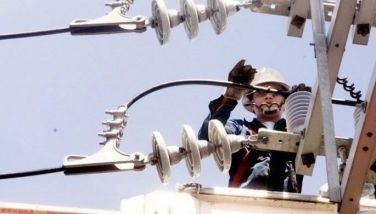Metro Manila’s sad mass transport system tale

Plumbing the internet for background material on various subject matters oftentimes yields some very interesting reading. I’d like to share in today’s column research that was put together by some academic scholars on the history of Metro Manila’s mass transport system.
The authors of the research are all from the University of the Philippines in Diliman. They are Ricardo Jose (Department of History and Third World Studies Center, College of Social Sciences and Philosophy); Daniel Mabazza, Jose Regin Regidor, and Marco Stefan Lagman (Department of Geography, College of Social Sciences and Philosophy) and Jonathan Villasper (Institute of Civil Engineering and National Center for Transportation Studies, College of Engineering).
In the research’s introduction, the authors pointed out that “several plans to move people to their destinations in an orderly fashion were drafted since the 1970s. Studying these plans shows that the current situation is a result of modifying or combining elements of one or more plans.”
Japanese-funded plan
The first plan was completed in 1973 with funding from the Japanese International Cooperation Agency. It was a truly comprehensive plan that included “road and highway development, the Philippine National Railways (PNR) and an ambitious subway/elevated rail system which would link the cities in the metropolis and decongest the city center by developing then sparsely populated areas near Manila.”
It was also in this plan that the system of circumferential roads, the most popular that we know today being C-5, was hatched. Five subway lines were also planned, with the main line passing through central Quezon City (Quezon Boulevard), the main school district in downtown Manila, through the business centers, port areas and on to the international airport.
Augmenting the subway lines would have been modern PNR trains running on elevated rails and serving areas outside of Manila that the subway trains would not reach.
The authors of the study contend that the first plan, which would take 15 years to complete, “may well have solved Manila’s traffic ills for many years to come, and opened up many potential business and residential centers outside of central Manila, including Marikina and Cainta in Rizal, and Marilao and Meycauayan in Bulacan.”
So where did the plan lose its appeal? Cost. It would have been too costly to dig tunnels and the underground rail lines, not to mention pay for all the rail cars of the five subway systems. If I remember right, there was even a lot of talk about fears of subway flooding given the notoriously ineffective Metro Manila flood control system then.
World Bank-funded plan
With former first lady Imelda Marcos as chair of the Metro Manila Commission, the Japanese-funded plan was severely criticized. Instead, a new plan was commissioned and funded by the World Bank.
Highlights of the 1977 World Bank study was the complete junking of the subway system in favor of the continued use of buses and jeepneys, supplemented by four light rail transit (LRT) lines running on existing roads.
Our academicians’ study noted that, “As light rail trains go, capacity was smaller than heavy rail trains.” Furthermore, they concluded that the World Bank study “did not foresee the overcrowding that soon became a feature of Manila’s LRT (forecast for 1980 was 190,000 to 216,00 daily; by 1990, 301,000 to 330,000 [actual volume in 2010 was 430,000 a day]).”
The World Bank plan was adopted, but with many changes made at the onset and while construction was ongoing. More importantly, instead of running at street-level, like in most European countries, the LRT-1 on Rizal Avenue was elevated.
The LRT-1 line was completed in 1985, more than a decade after the JICA-funded plan was initiated. It served Metro Manila commuters well for a few years, but by the middle of 2000, the railway cars would often break down from overcrowding.
Too many delays
During this time too, another study was completed with partial funding from the Australian Development Assistance Bureau (forerunner of AusAID). JICA also continued with its studies, largely being modifications and adaptations based on what the government had been implementing.
Meanwhile, Metro Manila’s traffic continued to deteriorate. The decision to fasttrack construction of the LRT-2 (Marikina to Recto) and MRT (along EDSA from North Avenue to Pasay) was deemed imperative. But with People Power and other issues, construction of the two lines was further delayed.
MRT became operational in 2000, while LRT-2 started running in 2004. Both became stand-alone projects due to financial issues before construction, hence the vast differences in operations and the subsequent difficulty of running the three lines under a seamless mass transport system.
It took a dictator, a new Philippine Constitution, an ousted president – more than three decades – to come up with three pathetic lines that lacked the simple foresight of responding to a growing number of commuters in the metropolis.
Conclusion
We’d like to share part of our university scholars’ conclusion: “By utilizing parts of several plans and not sticking to one plan, the overall fundamentals were thus negated, resulting in confusing, if not conflicting assumptions and infrastructure.
“Plans were influenced by people and events. The plans also reflected the thinking of the framers, and later planners criticized or disagreed with the basic lines of previous studies. Making things more complicated were pragmatic—particularly cost—considerations, political will and the possible influence of funding and construction agencies.”
We hope that with the current Build Build Build program of the current administration, such pitfalls may be avoided – and better foresight comes into play.
Facebook and Twitter
We are actively using two social networking websites to reach out more often and even interact with and engage our readers, friends and colleagues in the various areas of interest that I tackle in my column. Please like us at www.facebook.com and follow us at www.twitter.com/ReyGamboa.
Should you wish to share any insights, write me at Link Edge, 25th Floor, 139 Corporate Center, Valero Street, Salcedo Village, 1227 Makati City. Or e-mail me at [email protected]. For a compilation of previous articles, visit www.BizlinksPhilippines.net.
- Latest
- Trending































